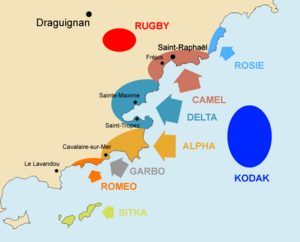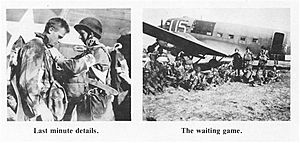1st Airborne Task Force (Allied) facts for kids
Quick facts for kids 1st Airborne Task Force |
|
|---|---|
| Active | 11 July – 23 November 1944 |
| Country | |
| Allegiance | Allies of World War II |
| Branch | |
| Type | Airborne forces |
| Role | Parachute infantry |
| Size | 9,000 |
| Engagements | Operation Dragoon |
| Commanders | |
| Notable commanders |
Robert T. Frederick |
The 1st Airborne Task Force was a special group of Allied soldiers during World War II. These soldiers were trained to jump from planes (paratroopers) or land in gliders. The group was formed in July 1944. Its main job was to help with a big invasion called Operation Dragoon. This operation was the plan to invade Southern France.
Major General Robert T. Frederick led the task force. On August 15, 1944, they took part in the "Dragoon" landings. Their mission was to secure the area north-west of the beaches where other troops were landing. After that, they moved towards the border between France and Italy. They were part of the United States Seventh Army. The 1st Airborne Task Force was active for only a few months. It was officially ended in November 1944.
Contents
How the Task Force Was Formed
At first, there were plans to invade France in two places at once. One invasion would be in Normandy (Northern France). The other would be in Southern France. The idea was to attack the Germans from both directions. This is like a pincer movement, where two forces squeeze the enemy.
However, there weren't enough ships or soldiers for both invasions at the same time. So, the invasion of Southern France was put on hold. It was later planned for August 1944 and named "Operation Dragoon."
For this new operation, all available airborne forces were brought together. On July 11, 1944, a new unit was created. It was first called the Seventh Army Airborne Division (Provisional). A few days later, on July 21, it was renamed the 1st Airborne Task Force.
To create this task force, some airborne units were moved from fighting in Italy. These included:
- The U.S. 509th Parachute Infantry Battalion.
- The U.S. 517th Parachute Regimental Combat Team.
- The British 2nd Independent Parachute Brigade.
Other units joined too. The U.S. 550th Glider Infantry Battalion and the U.S. 551st Parachute Infantry Battalion came from Panama. These two units had not yet seen combat. Two French parachute battalions were supposed to join. But, there were disagreements, so they did not become part of the force. The British 2nd Parachute Brigade joined instead. They agreed to help, but only if they could return to Italy after the beach area was secure.
Operation Dragoon: The Big Jump
The 1st Airborne Task Force's part in "Operation Dragoon" was called "Operation Rugby." Their job was to land near a village called Le Muy. This village was located between Draguignan and the landing beaches at Fréjus–Saint-Raphaël.
There were three main areas where the troops would land. These were called Drop Zones (DZ) for paratroopers and Landing Zones (LZ) for gliders:
- The British 2nd Parachute Brigade landed at DZ/LZ "O." This was an area of open fields and vineyards north of Le Muy. The U.S. 550th Airborne Infantry Battalion also landed here later.
- The U.S. 517th Parachute Regimental Combat Team landed at DZ/LZ "A." This area had narrow fields west of Le Muy. The 1st Battalion, 551st Parachute Infantry Regiment followed them later.
- The 509th Parachute Infantry Battalion and the 463rd Field Artillery landed at DZ "C." This area was south-east of Le Muy. It was rocky and wooded, with hills all around. It was chosen so troops could control the high ground overlooking Le Muy.
The Landings Begin

On the night of the operation, a thick fog made things difficult. Many paratroopers landed far from their planned spots. By morning, only about 60% of the soldiers had gathered in their correct drop zones. The gliders carrying British artillery support had to turn back. However, later landings and drops that day were more successful. Many gliders were damaged when they landed, but luckily, not many soldiers were hurt.
Fighting for Control
The village of Le Muy was still held by the enemy. But the British soldiers secured the high ground to the east and north of the village. American soldiers did the same in the west and south. The 550th Battalion tried to capture Le Muy that night but were pushed back.
Even without taking the village, the 1st Airborne Task Force had completed its main mission. They had set up a strong position in the Argens valley. This stopped the enemy from moving towards the main beach-head.
On the morning of August 16, the 550th Battalion attacked Le Muy again. By 2:45 PM, the village was captured. Between 500 and 700 enemy soldiers were taken prisoner. Early on August 17, soldiers from the U.S. 36th Division arrived at Le Muy from the beaches. They then continued their advance towards Draguignan.
After "Operation Rugby," the 1st Airborne Task Force moved north-east. They protected the right side of the Seventh Army. They helped free cities like Cannes and Nice. Later, they were sent to the Maritime Alps. Here, they patrolled and watched the Germans near the French-Italian border.
The British 2nd (Independent) Parachute Brigade left the task force on August 26, 1944. Six weeks later, they were sent to Greece. In November 1944, the 1st Airborne Task Force went to Soissons to rest and get new supplies. It was officially ended on November 23, 1944. Most of its units then joined the XVIII Airborne Corps.
Who Was in the Task Force
The 1st Airborne Task Force was made up of several different military units.
Main Fighting Units
- 1st Airborne Task Force Headquarters – Led by Major General Robert T. Frederick.
- U.S. 509th Parachute Infantry Battalion – Led by Lieutenant Colonel William P. Yarborough.
- This unit included the 463rd Parachute Field Artillery Battalion.
- U.S. 517th Parachute Regimental Combat Team
- This team included the 517th Parachute Infantry Regiment, the 460th Parachute Field Artillery Battalion, and the 596th Airborne Engineer Company.
- U.S. 550th Airborne Infantry Battalion (Glider) – Led by Lieutenant Colonel Edward I. Sachs.
- U.S. 551st Parachute Infantry Battalion – Led by Lieutenant Colonel Wood G. Joerg.
- This unit included the 602d Glider Field Artillery Battalion.
- British 2nd (Independent) Parachute Brigade – Led by Brigadier Charles Hilary Vaughan Pritchard. (This unit left on August 26).
- This brigade included the 4th, 5th (Scottish), and 6th (Royal Welch) Parachute Battalions. It also had the 1st Independent Parachute Platoon (Pathfinders).
- 1st Special Service Force (U.S./Canada) – Led by Colonel Edwin A. Walker. (This unit joined on August 22).
Support Units
These units helped the main fighting forces with things like communications, engineering, and medical care.
- 512th Airborne Signal Company (for communications)
- 887th Airborne Engineer Aviation Company (for engineering tasks)
- Antitank Company, 442nd Infantry Regiment (for fighting tanks)
- 552nd Antitank Company
- Company A, 2nd Chemical Mortar Battalion
- Company A, 83d Chemical Mortar Battalion
- Detachment, 3d Ordnance Company (for weapons and supplies)
- 676th Medical Collecting Company (for treating wounded soldiers)
Base Support Units
These units helped with logistics and supplies behind the front lines.
- 3358th Quartermaster Truck Company (for transport)
- 334th Quartermaster Depot Company (for supplies)
- 172d Detail Issues Depot, British Heavy Aerial Resupply Company (for air supplies)
- 904th Air Base Security Battalion (for base protection)
Air Transport Units
These units provided the planes and gliders for the airborne operations.
- Provisional Troop Carrier Air Division – Led by General Paul L. Williams.
- This included the 50th, 51st, and 53rd Troop Carrier Wings.
- It also included the Glider Pilot Regiment.
Fighter Support
- 31st Fighter Group (provided air cover from August 13 to August 16, 1944).
See also




